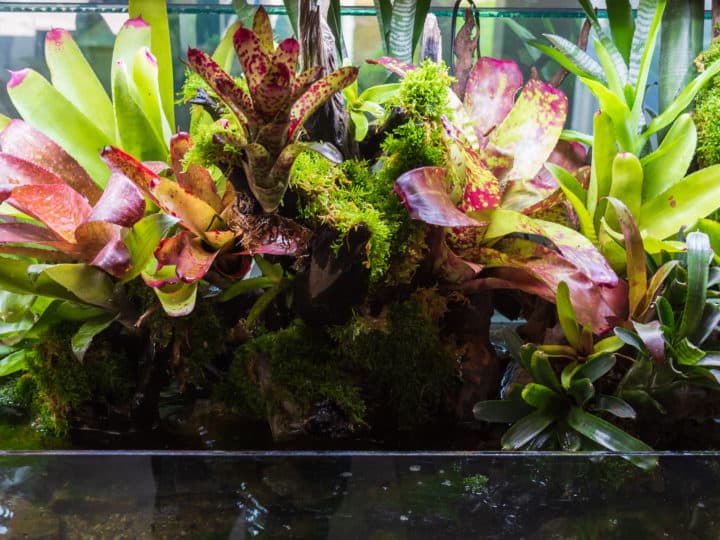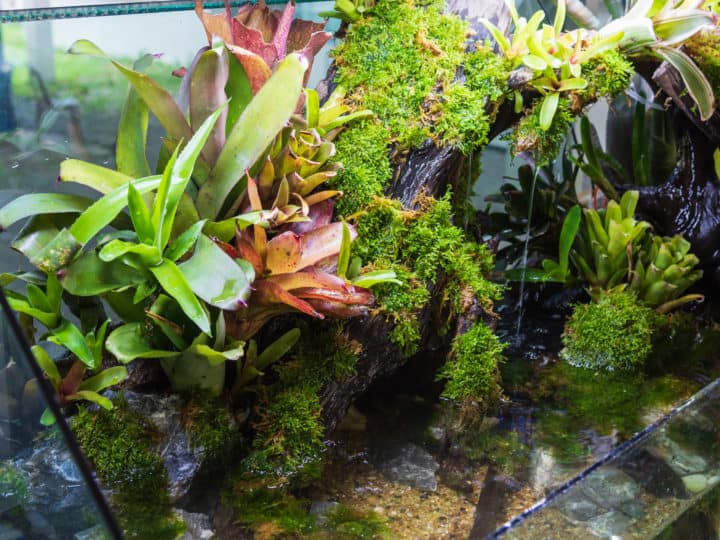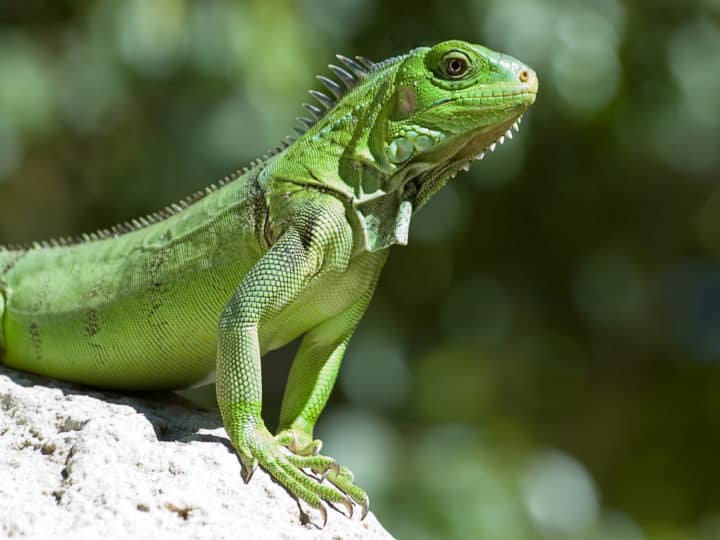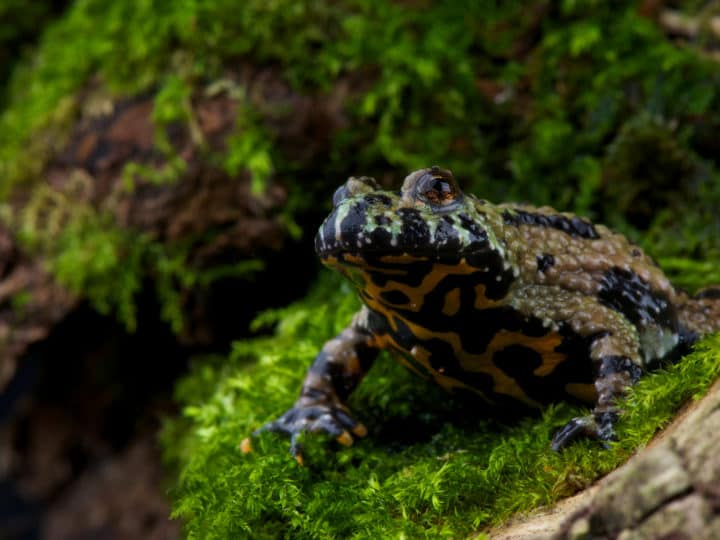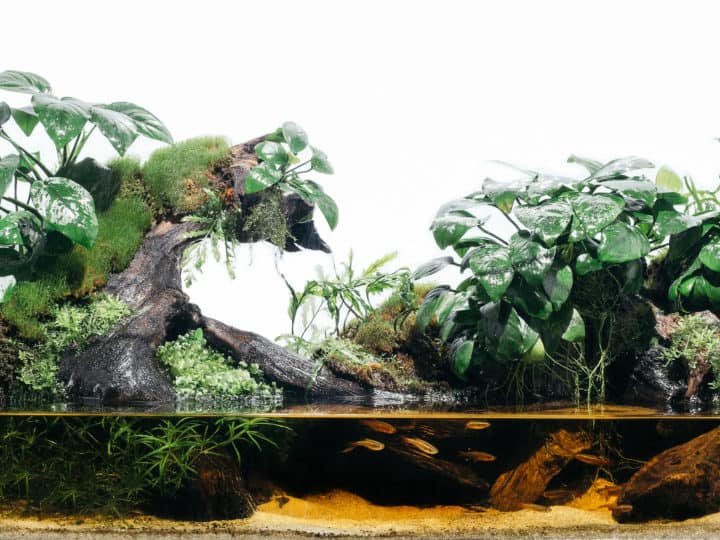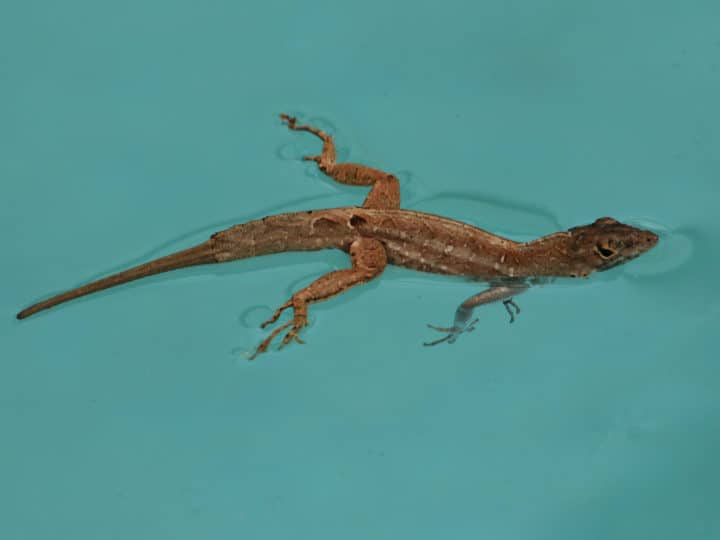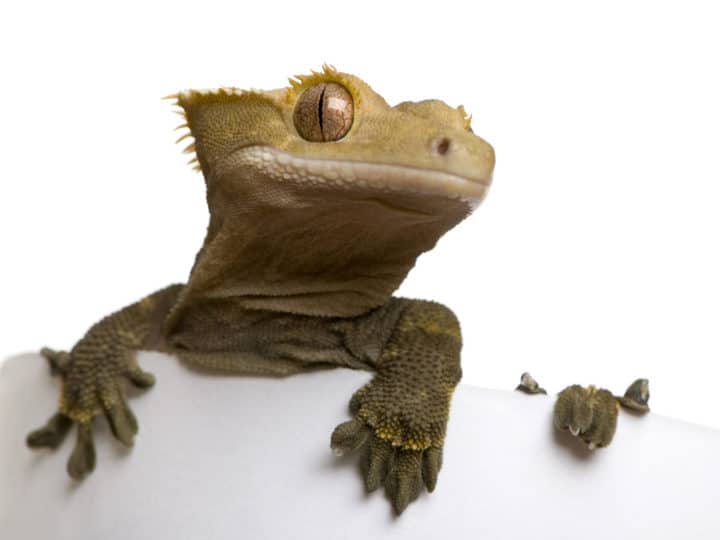Ferns are ideal for paludariums as they can provide shelter for fish and make the paludarium visually appealing. You’ll want aquatic ferns for your paludarium as they can naturally grow near a lot of water. There are many types of ferns to choose from and choosing the best ones is essential to help you create a paludarium you can be proud of.
Here’s a list of 7 best ferns for a paludarium:
- Java Fern
- Congo Fern
- Oriental Water Fern
- Holly Fern
- Fragrant Maidenhair Fern
- Broad-leaf Water Sprite
- Boston Fern
Many ferns thrive in paludariums because they provide the perfect balance of aquatic and terrestrial environments. Most ferns that are best for paludariums are easy to care for and are adaptable to their environment. Read on to learn more about keeping ferns in a paludarium.
1. Java Fern
The Java Fern is an excellent fern for new plant owners. They’re aquatic ferns that will do well in a paludarium. These plants are unique because they can grow in various environments, be it underwater, partially in the water, or above ground. They’re mainly freshwater plants, but they can grow in other water environments. Java Ferns are highly adaptable to their environment, making them easy to care for.
These ferns are native to South Asian jungles. They grow best on the ground with many rocks and tree roots. So be sure to add plenty of stones and gravel to your paludarium.
Java Ferns can grow in various temperatures ranging from 60 to nearly 85°F (16 to 29°C), but they need constant moisture. Put these ferns in a humid paludarium so that they can thrive.
These ferns tend to grow a little over a foot (30 cm) tall, and you can put them in various paludarium sizes. Their leaves differ in size and shape depending on the type of Java Fern you have, and they are narrow, twisted, wide, or thin. The plants can grow in low light, and they don’t need an excessive amount of water in their paludarium. Their roots attach to dry ground, but they will survive as long as the paludarium maintains its moisture.
2. Congo Fern
Congo Ferns, otherwise known as African Water Ferns, are incredibly adaptive, and they can grow almost anywhere. They attach their roots to gravel, trees, rocks, and even decorative objects, so they can thrive in various locations. These plants require relatively low maintenance because they don’t rely on soil for nutrients. Instead, they can adapt to their surroundings.
Congo Ferns are native to tropical areas of Africa and Asia, and they grow best in warmer temperatures between around 70 and 80°F (21 and 27°C).
Put these plants in a tank with a significant amount of water since they naturally grow around fast rivers, streams, and lakes. Be sure to add sand and rocks so they have something on which to attach their roots. It’s best to put these plants at the bottom of a tall paludarium since they grow very tall.
Because Congo Ferns grow so tall, they serve as incredible decorations to your tank. They can cover unseemly areas of your paludarium and provide an extra layer of visual appeal to your tank. Thankfully, they don’t need any particular soil to grow in, so you can add them to many paludarium environments.
3. Oriental Water Fern
The Oriental Water Fern is a highly adaptable fern that requires relatively little care. It is an aquatic plant.
However, note that the orientall Water Ferns don’t have to be fully submerged in water to grow. They can grow well even if they’re partially in the water. These plants are native freshwater plants. However, they can grow in other water conditions as well.
Oriental Water Ferns should be in a paludarium with a lot of water. Although they don’t need to be completely submerged, you shouldn’t put them in a relatively dry paludarium. The ferns often float in the water or attach their roots to rocks and gravel. When left floating, they require very little maintenance and can survive for extended periods of time.
Don’t put these plants near water filters because their leaves can get sucked into the filter, damaging the plant. Oriental Water Ferns provide excellent decoration to any paludarium and fill any empty spaces in your tank. They can grow around a foot (30 cm) tall, and you can put them in various paludarium tanks.
These ferns are highly adaptive, and you can find them in tropical areas worldwide. They’re native to slow-moving waters.
Keep these plants at room temperature around 70°F (21°C). As mentioned earlier, you can plant an Oriental Water Fern or let it float. Floating, the roots may appear thinner, but that’s no reason for alarm.
4. Holly Fern
The Holly Fern, otherwise known as Arachniodes aristata, gets its name because of its holly-shaped leaves. These ferns are native to Eastern parts of Asia, and they can grow up to 2 feet (60 cm) tall and 3 feet (90 cm) wide. Because they grow so large, you’ll need to put these in a paludarium with a lot of space.
The Holly Fern works well as a background plant or covering the ground. They thrive in humid, moist environments. These plants aren’t aquatic, so you shouldn’t put them in too much water. The soil or substrate should be moist but well-drained. They also require soil that has significant amounts of hummus nutrients.
5. Fragrant Maidenhair Fern
Fragrant Maidenhair Ferns, otherwise known as Delta Maidenhair Ferns or Maidenhair Ferns, are native to South American rainforests, and they prefer wet, humid conditions. They’re durable plants, and their leaves can “deflect water,” helping them withstand harsh rainy conditions.
Because these ferns are native to the rainforest, they can grow in various temperatures ranging from the low 50s to the high 70°F (around 10 to 21°C). However, it would be best to keep their temperature constant in a paludarium environment, so aim to keep them at around 70 degrees. They’re native to tropical areas, so keep these ferns at a temperature higher than 60°F (16°C).
Fragrant Maidenhair Ferns are not aquatic plants, so you’ll need to plant them above ground. You can place them at the forefront of your paludarium or in the background. They grow about a foot (30 cm) tall, and they help cover the ground. Additionally, they provide great decor to your tank.
Fragrant Maidenhair Ferns are another adaptable plant. Although they prefer humid, moist soil, they can attach their roots to rocks, gravel, and in-between cracks to survive. Although naturally versatile, they’re not the best plant for new plant owners. But they will go well in various locations within a paludarium.
It would help to plant Fragrant Maidenhair Ferns among very moist substrates (mulch, bark, moss, etc.). However, don’t overwater the soil; otherwise the ferns won’t grow. The soil should be reasonably acidic and should drain quickly so that the soil doesn’t accumulate water.
6. Broad-Leaf Water Sprite
The Broad-leaf Water Sprite, otherwise known as Ceratopteris cornuta, is another aquatic fern perfect for paludariums. The fern is known for its large, broad leaves.
The Broad-leaf Water Sprite can grow in different ways:
- Fully submerged in water
- Partially submerged
- Planted
- Free-floating
These plants are relatively low maintenance, and they’re perfect for new plant owners and paludarium users. The Broad-leaf Water Sprite is an adaptive plant, and it can grow in a variety of water, environment, and weather conditions.
These plants only grow about a foot (30 cm) tall, so that you can put them in different types of paludariums. The best temperature to keep them is around 70°F (around 21°C), and you can keep them under low or medium light. Use moist soil in your paludarium if you choose to root the plant.
Broad-leaf Water Sprites are native to tropical regions worldwide, and you can find them among slow-moving bodies of water. When planted among nutrient-rich substrates, they’ll grow swiftly. You can plant them in the substrate or root them in rocks or pieces of wood in your tank.
Many people enjoy adding the Broad-leaf Water Sprite to their paludariums because:
- They’re bright green and add rich color to the tank.
- They provide excellent shelter for other fish in the tank. You can put these plants in the background or the middle of a paludarium tank, and they work great in tanks that have fish in them as well.
- They tend to live a long time.
- They’re versatile.
7. Boston Fern
The Boston Fern, otherwise known as the sword fern, is native to tropical regions worldwide. Therefore, they thrive in moist and humid environments. Boston Ferns are suitable for new plant owners because they’re relatively easy to care for and are widely available to purchase. They need low to medium light levels.
These plants are not aquatic plants, and they require moist and well-drained soil. Boston Ferns add significant visual appeal to paludariums, but they’re best in larger paludariums because of their size. They can grow up to three feet (90 cm) tall and wide. Keep your fern supplied with nutrient-rich and fertile soil.
Because they’re native to tropical regions, it’s best to keep these ferns in warmer temperatures, ideally between 60 and 95°F (16 to 35°C). Aim to keep your temperature constant so that your fern grows appropriately. Boston Ferns don’t grow well in extreme and fluctuating temperatures.
Sources
- Bantam Earth: African Water Fern (Bolbitis Heudelotii)
- Bantam Earth: Java Fern (Microsorum Pteropus)
- Bantam Earth: Water Sprite Plant (Ceratopteris Thalictroides)
- Pantophiles: Easy Low Light Aquarium Plants Aqua-Buffs Should Know!
- Bantam Earth: Delta Maidenhair Fern (Adiantum Raddianum)
- Bantam Earth: Paludarium Plants
- Aquarium Domain: Water Sprite
- Gardening Know How: Growing Holly Ferns: Information On Holly Fern Care
- Paludariums: Paludarium Plants

